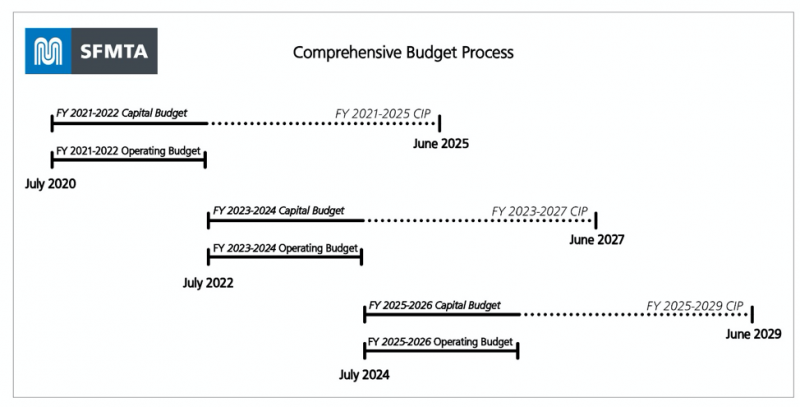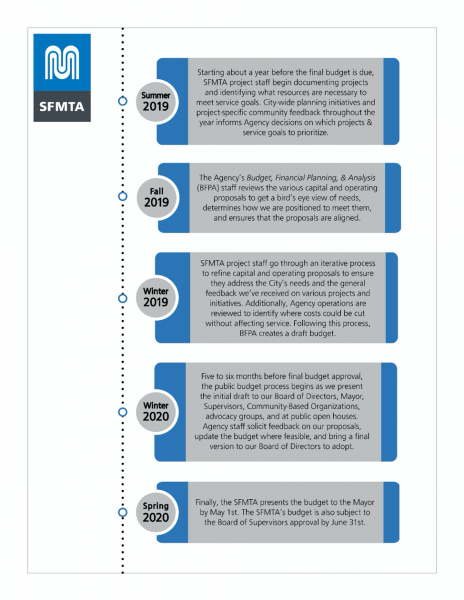Popular Posts
Translate
Home Top Ad
Contact Form
The SFMTA Budget Process
By
Overview of the SFMTA Budget Development Process
Every two years, the San Francisco Municipal Transportation Agency (SFMTA) must finalize and adopt a consolidated budget with projected revenues and expenditures for the following two years[1]. Currently the FY2021 & FY2022 budget process is underway, and community members can participate in the budget process in the coming weeks. On May 1st, the Mayor approves the budget and sends it to the Board of Supervisors for a final vote. This blog, the first in a series diving into the budget process, will provide a high-level overview of the SFMTA consolidated budget components, purpose, and development process. The blog posts that follow will build upon this overview and cover specific SFMTA budget topics:
- Revenue, Expenditures, and our Forecast
- Policy objectives and funding priorities
- Overview of outreach
- Adopted Budget and What it includes
What is the SFMTA Budget Process?
The consolidated budget covers a two-year period and has two parts: the Operating and the Capital budgets. The Capital budget is for new and on-going projects; the Operating budget is for daily services[2] and maintenance. For example, buying new LRV4 trains to replace our light rail fleet is within the Capital budget, while the salaries of our train operators is within the Operating budget. As the example shows, the Operating and Capital budgets are developed in tandem for the SFMTA’s budget process.
Additionally, the Capital budget reflects the first two years of the five-year Capital Improvement Plan (CIP). The CIP is a policy document detailing the projects that the agency aims to implement over the five-year period and is based on city-wide planning initiatives & project-specific feedback. A new CIP is developed each budget cycle, meaning that the outer three years of the current CIP are reevaluated, adjusting projects to evolving policies and conditions. For example, as the need for our new LRV4 trains became more urgent, we changed our plan so that the trains could be bought sooner.
The five-year CIP and two-year Capital and Operating budget documents show how the SFMTA plans to allocate available resources to meet our Strategic Plan goals. Both the consolidated budget and the CIP are submitted to the SFTMA Board for approval. Following this, the budget is submitted to the Mayor and the Board of Supervisors for review and approval.
Why does the budget matter?
The budget is the strongest reflection of our values. It is a commitment and a plan for how we will dedicate resources to better serve the public. The SFMTA’s projects and services are limited by funding[3], requiring the SFMTA to make difficult choices about what needs should be prioritized and funded. The budget details how and when we will implement relevant projects and meet our goals.
How does SFMTA develop the budget?
Generally, the budget is developed through the following 5 steps:
Where to find additional information
In the upcoming weeks, we will be publishing additional blogs that will provide more detail on specific aspects of the budget process. For additional questions, please review the following documents or email sfmtabudget@sfmta.com.
- SFMTA Strategic Plan (2018)
- Details our vision, what we need to do to get there and how we will measure progress along the way.
- SFMTA Board of Director's Presentation (3/17/2020)
- The most recent public presentation of the proposed budget (FY21 and 22) along with the challenges and decisions that the board will have to facilitate.
- SFMTA 20-year capital plan (2017)
- This is a fiscally unconstrained assessment of the SFMTA’s anticipated capital needs in the next 20 years. It identifies the investment needed to meet the agency’s and city’s transportation goals, and informs the Capital side of each two-year comprehensive budget
- SFMTA 5-year Capital Improvement Program (2019)
- This details the fiscally constrained set of projects that the agency aims to implement by June 30th, 2024, based on city-wide planning initiatives & project-specific feedback.
- SFMTA Performance Metrics
- These interactive dashboards track the agency’s progress in meeting its goals and objectives as outlined in the Strategic Plan
- SFMTA Automatic Indexing Policy
- For more information on how the agency sets charges based on inflation
- SFMTA Contingency Reserve Policy
- For more information on how the agency works to ensure financial stability
Coming up next in our series: Revenue & Expenditures
[1] The 2-year budget cycle is required as a result of voters passing 2009’s Proposition A
[2] Per City Charter, the types of services that the SFMTA provides are mandated
[3] Per City Charter, the SFMTA budget must be balanced, meaning that projected expenditures must be no greater than our projected revenues.
Published March 20, 2020 at 02:42AM
https://ift.tt/2QxyN8X





0 Comments